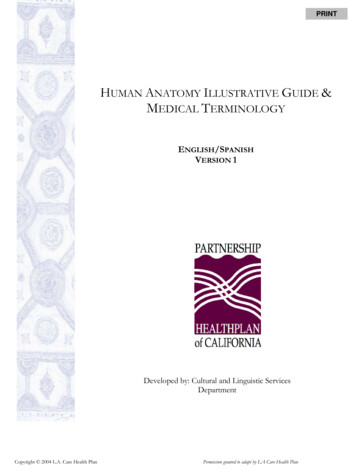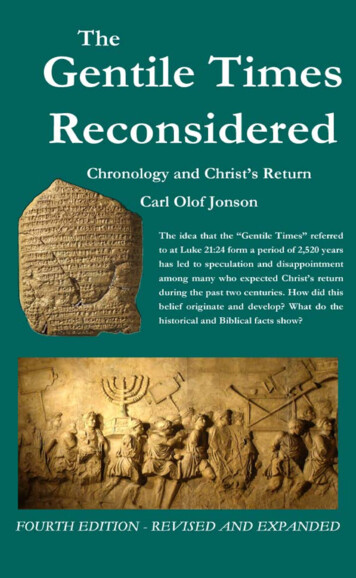
Transcription
PRINTHUMAN ANATOMY ILLUSTRATIVE GUIDE &MEDICAL TERMINOLOGYENGLISH/SPANISHVERSION 1Developed by: Cultural and Linguistic ServicesDepartmentCopyright 2004 L.A. Care Health PlanPermission granted to adapt by LA Care Health Plan
IntroductionThe Human Anatomy Illustrative Guide and Medical Terminology was developed out of a need that wasidentified through our training programs on health care interpreting and instructing clinical staffon how to work with an interpreter. We heard from bilingual/multilingual staff that they neededtools that would help them communicate with limited English proficient (LEP) patients. Fromour evaluative work, we also understood that some bilingual/multilingual staff also needed toknow human anatomy terms in English as well as the target language. In our mission to close thelanguage gap, we developed the bilingual anatomy chart that includes human anatomical charts,medical terms, and frequently asked questions by doctors during their interactions with patients,in Los Angeles County’s ten threshold languages (Armenian, Chinese, English, Farsi, Khmer,Korean, Russian, Spanish, Tagalog, and Vietnamese).Communication is a critical link to patient safety, quality of care, access to needed health careservices, and patient satisfaction. The rapid changes that occur in health care settings createmany challenges and opportunities to develop innovative ways of communicating with patients,particularly with linguistically diverse patient population. This resource is in alignment with L.A.Care’s over arching mission which is:“To ensure the provision of culturally sensitive and linguistically competent quality health care services to the MedCal population in Los Angeles County through the Safety Net Providers and our health partners, to promotehealth and disease prevention, to continuously improve the knowledge and effectiveness of our provider community,and to assist in the provision of the same quality of services for the vulnerable populations.”L.A. Care wishes to acknowledge all those that have contributed to the development of thisguide. First and foremost, we must thank The Cross Cultural Health Care Program for allowingus to use the illustrations from the “Bridging the Gap” interpreter’s handbook. SarkisSemerdjyan, Fatima Rodriguez and Elizabeth Nguyen were key staff members of the Culturaland Linguistic Services Department at L.A. Care, who put much energy and effort to ensure thequality of this guide. We also would like to thank the Marketing Department, Young Chi inparticular, for her assistance with the layout of the guide.Together in Health,Beatriz M. Solís Director of Cultural andLinguistic Services
Human Anatomy – The Circulatory SystemSpanish
Human Anatomy-The Digestive SystemSpanish
Human Anatomy - The Endocrine (Ductless Gland) SystemSpanish
Human Anatomy - The Optical SystemSpanish
Human Anatomy - The Male Reproductive/Urinary SystemSpanish
Human Anatomy - The Female Reproductive SystemSpanish
Human anatomy - The Respiratory SystemSpanish
Medical Terminology & Frequently Asked Questions by Providers DuringEncounters with Patients1. Abdominal paindolor abdominal2. Acquired Immunodeficiency Syndrome(AIDS)síndrome de inmunodeficiencia adquirida (SIDA)3. Allergiesalergias4. Appendicitisapendicitis5. Arthritisartritis6. Asthmaasma7. Bronchitisbronquitis8. Cervical cancercáncer cervical, cáncer del cervix9. Chest paindolor en el pecho10. Chicken poxvaricela (viruelas)11. Chlamydiaclamidia12. Constipationestreñimiento13. Contraceptiveanticonceptivo (contraceptivo)14. Cystquiste15. Diabetesdiabetes16. Dietdieta, régimen alimenticio17. Difficulty breathingdificultad al respirar18. Diphtheriadifteria19. Discharge (e.g. a discharge fromvagina)theflujo, desecho, secreción20. Dizzinessmareo21. Drugs (illegal drugs)drogas ilicitas22. Earachedolor de oído23. Ectopic pregnancyembarazo ectópico, gestación fuera24. Feverfiebre25. Human Immunodeficiency Virus (HIV)Virus de inmunodeficiencia (VIH)26. Hemorrhoidshemorroides
27. Hepatitishepatitis28. Hypertensionhypertension, alta presión29. Ulcerulcera, llaga, lesión30. Measlessarampión31. Mumpspaperas, parotiditis32. Pap smearprueba de papanicolaou33. Pneumonianeumonía, pulmonía34. Sexually transmitted diseases (STDs)enfermedades trasmitidas sexualmente35. Shortness of breathfalta de respiración36. Sore throatdolor de garganta37. Stomach achedolor de estómago38. Tetanus shotvacuna contra el tétano39. Toothachedolor de muela40. Tuberculosistuberculosis41. Urinary infectioninfección renal, infección urinaria42. Urine analysisanálisis de orina43. Vaccinationvacunación, inoculación de una vacuna44. Varicose veinvárices, venas varicosas45. Whooping coughtos ferina46. Yeast infectionhongo vaginal, infección vaginal47. Are you in pain?¿Siente dolor?48. Are you taking any medications?¿Está tomando algún medicamento?49. Are your stools normal?¿Su excremento es normal?50. Do you feel dizzy?¿ Se siente mariado?51. Do you have a fever?¿Tiene fiebre?52. Do you have a runny nose?¿Le gotea la nariz?53. Do you have numbness or tingling?¿Está entumecido o siente hormigueo?54. Hold your breathMantenga la respiración
55. Is the pain a sharp pain or dull pain?¿El dolor es agudo o sordo?56. May I help you?¿Le puedo ayudar?57. How did you hurt yourself?¿Cómo se lastimo?58. Have you ever had this problem before?¿Ha tenido este problema anteriormente?59. Does anyone in your family have asthma?¿Hay alguien en su familia que tiene asma?60. Has anyone in your family been treated fordiabetes?¿Ha recibido algún miembro de su familia tratamientopor la diabetes?61. Has your child been vaccinated?¿Ha sido vacunado su niño(a)?62. Have you ever had any operations?¿Le han hecho alguna cirugía anteriormente?63. Do you have any allergy to any food ordrug?¿Tiene alguna alergia a ciertas comidas omedicamentos?64. Do you have any trouble with your throat?¿Tiene algún problema en su garganta?65. Have you been going to the bathroomregularly?¿Ha estado yendo al baño regularmente?66. Has your baby been tugging at his ear alot?¿Se ha estado jalando la oreja mucho su bebé?67. Which tooth is bothering you?¿Cuál diente le está molestando?68. When was the last time you saw a dentist?¿Cuándo fue la última vez que vio el dentista?69. When was your last menstrual period?¿Cuándo tuvo su última regla menstrual?70. Is this your first pregnancy?¿Este es su primer embarazo?71. Have you ever had a miscarriage?¿Ha tenido malpartos (abortos espontáneos) en elpasado?¿Tuvo alguna complicación con sus otros embarazos?72. Did you have any complications with yourother pregnancies?73. Were any of your children born by Csection?¿Ha tenido partos por cesaria?
74. How many months pregnant are you now?¿Cuántos meses de embarazo tiene?75. How much weigh have you gained?¿Cuánto peso ha aumentado?76. Have you received prenatal care?¿Ha recibido cuidado prenatal?77. When did you start having contractions?¿Cuándo empezó a tener contracciones?78. Will you be breastfeeding your baby?¿Le dará pecho a su bebé?79. What seems to be the problem with yourchild?¿Cuál parece ser el problema con su niño(a)?80. Was he unconscious after he fell?¿Estuvo inconsciente después de haberse caído?81. Did he appear to be in pain?¿Le pareció que él tenía dolor?82. Has he been vomiting?¿Se ha estado vomitando?83. How did you cut yourself?¿Cómo se cortó?84. Is there any swelling?¿Hay alguna hinchazón?85. Has the baby had any diarrhea?¿Ha tenido diarrea el bebé?86. Was there any blood in the stool?¿Hubo sangre en el excremento?87. Do you ever vomit when you have thisstomach pain?¿Se vomita cuándo le da dolor de estómago?88. Do you often have stomach cramps orfever?¿Sufre usted de calambres estomacales o fiebre amenudo?Permission to use granted by LA Care Health Plan
medical terms, and frequently asked questions by doctors during their interactions with patients, in Los Angeles County’s ten threshold languages (Armenian, Chinese, English, Farsi, Khmer, Korean, Russian, Spanish, Tagalog, and Vietnamese). Communication is a critical link to pati











